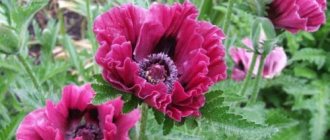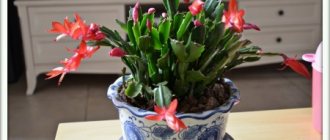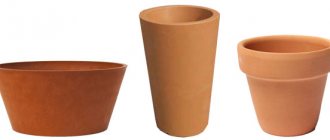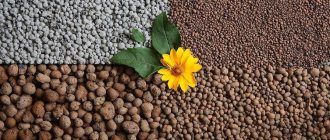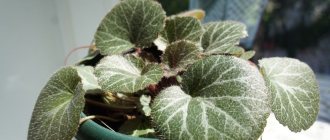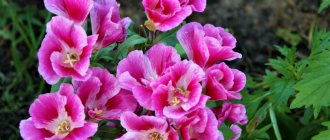Don’t know how to properly grow strong summer seedlings? Our article will help you avoid making mistakes and get a beautiful flower garden.
Using attractive annuals, you can create a bed of continuous flowering. To do this, the first step is to determine the optimal time for sowing seeds for seedlings. Plants that bloom within a couple of months after sowing (verbena, gatsania, lipweed, coleus, bluebell, pelargonium, sparkling salvia, fragrant tobacco, snapdragon, cineraria maritima) are sown in January-February. But mass sowing of annuals occurs in March and April.
Sowing dates for annual plants in central Russia
| Seed sowing time | Plant name |
| First half of March | Anemone, aster, anacyclus, seaside armeria, asparagus, adonis, Chinese carnation, gomphrena, kupena, kufeya, lacfiol, mirabilis, mesembryanthemum, euphorbia bordered, nolana, pyrethrum, sanvitalia, scabiosa, salpiglossis, platycodon, navel, helianthemum, aspen, primrose , soapwort, edelweiss, sage, immortelle. |
| Second half of March | Ageratum, arctotis, climbing azarina, brachycoma iberisolifolia, venidium, dianthus, helichrysum, godetia, dolichos, morning glory, cleome, lavatera, summer gillyflower, lobularia, nasturtium, nemesia, osteospermum, perilla, penstemon, Drummond's phlox, chrysanthemum, echinacea, echium. |
| First half of April | Arctotis, annual aster, basilisk, cottonweed, helipterum, iberis, kniphofia, xeranthemum, lobularia, fragrant mignonette, scabiosa. |
| Second half of April | Amaranth, marigolds, annual dahlia, datura, diascia, sweet pea, ornamental cabbage, clarkia, purslane, celosia, zinnia. |
Containers for flower seedlings
It is best to grow flower seedlings in separate pots, so as not to have to pick seedlings later. Such seedlings grow stronger and, as a rule, are not affected by rot.
Both small disposable cups and large boxes are suitable as containers for flower seedlings. The main thing is that there are holes made in the bottom of the container to drain excess water, and there is also a tray.
Seedlings of compact plants can also be grown in peat tablets or peat humus cups
How to water tomatoes correctly
First, when the seeds have not yet awakened, the soil is sprayed and covered with polyethylene or other covering material. Soil irrigation takes place daily, in the morning.
When the seedlings appear, the covering material is removed and the seedlings stop watering. This should take from two to four days. Afterwards, the watering schedule changes: the sprouts are watered no more than twice a week, trying to ensure that the soil is not too dry or too wet. It is important to consider the room temperature. If the air is hot, above 25 degrees, then watering is necessary more frequently.
When the plants are about to be planted, watering should be stopped a couple of days before. When the seedlings are transplanted into separate cups, there is no need to water them. You need to wait four to five days. Then water once a week.
How to grow tomatoes at home
Soil for seedlings
Under no circumstances should you use soil in which indoor or container plants have already grown. For seedlings it is necessary to take new soil. If you want to save money, you can prepare the soil mixture yourself. At the same time, do not forget to disinfect it: heat it in the oven for an hour at 50°C.
The substrate for seedlings of most annuals should consist of turf and leaf soil, humus and sand, taken in equal proportions. Only some crops require a different soil composition. For example, for flowers susceptible to the formation of blackleg (ageratum, aster, gillyflower, lobelia, snapdragon, petunia, fragrant tobacco), you need soil that contains turf soil, peat and sand in a ratio of 3:1:1.
No. 1 Water for irrigation
Water is the source of life
Water quality plays an important role in irrigation. Use warm water at room temperature (+20-+25C). From the tap it sits for 2 days. During this time, chlorine evaporates, and salts settle at the bottom in the form of flakes.
The ideal approach is rain, melt or well water, but this option is only available to rural residents.
Using tap water does not promote seedling growth
Distilled liquid that is devoid of salts is not suitable. Boiled water is not suitable, it has no oxygen, and some useful salts turn into an insoluble precipitate. Chlorine forms toxic compounds after boiling. In addition, after heat treatment, the structure of water changes. Watering with cold, unsettled water causes the death of immature shoots.
Hard water that is saturated with salts can be softened in the following way:
- add 2 tbsp to 2 liters of water. l. ash
- dilute 100 g of fresh peat in 10 liters of liquid
- stand for 1-2 days, draining the sediment
How to prepare melt water
Melt water is distinguished by its structure and has a beneficial effect on the growth of seedlings
Melt water is one of the most useful. It is believed that it has a special structure that has a beneficial effect on the growth of plants in general and seedlings in particular.
If snow and ice are not available, then we create melt water ourselves:
- pour tap water into the bottle, leaving room for the liquid to expand after freezing
- wait until the bulk of the moisture freezes
- drain the liquid from the central part of the bottle: it contains harmful impurities and salts
- let the remaining ice melt naturally and use it for watering
Natural melt or rain water can only be used if industrial facilities are located remotely. Far from the city, in rural areas, such water is most useful for seedlings.
Sowing seeds for seedlings
Place drainage made of expanded clay, gravel or broken brick 1 cm thick at the bottom of the container. Then place a moist (but not too wet!) substrate so that about 2 cm remains to the top of the container.
Sow large seeds in pre-made furrows to a depth equal to three times the size of the seed, and lightly compact the soil. Sow medium-sized seeds in the furrows, but only lightly sprinkle them with soil (the layer should not exceed 0.5 cm). Mix very small seeds with dry sand, scatter them over the surface of the soil and water them with a spray bottle.
Cover the container with glass or plastic wrap and place in a warm place. Please note: until seedlings appear, the soil should always be slightly moist.
The optimal temperature for germination of seeds of heat-loving plants is 25-30°C, cold-resistant plants are 15-18°C
After germination, remove the glass or film and keep the plants at a temperature of about 20°C. When the seedlings grow up, sprinkle their stems a little with light soil and place the plants in a well-lit place with a temperature of 15°C.
No. 5 Combination of watering and fertilizing
Fertilizing strengthens the plant's immunity and increases green mass
To obtain strong, healthy garden crops, the procedure for fertilizing seedlings is important. In the first stages, it is necessary to feed the grown seedlings with urea, which promotes the growth of green mass.
It is not necessary to add mineral compounds. For these purposes, mullein and bird droppings are actively used, diluted in a certain ratio (concentrated compositions will burn the roots).
Most berry and vegetable crops love neutral or alkaline soils. Ash will help create the right environment. Egg shell powder is also effective, delivering calcium, magnesium, phosphorus to the soil and deoxidizing it. It “works” especially well in relation to nightshades: tomatoes and sweet peppers.
How to properly water seedlings with nutritional compounds? We offer several options:
- Ammonia strengthens plants and stimulates the growth of green mass. 1 tsp. ammonia is diluted in 10 liters of water and used for irrigation
- Iodine solution improves the immunity of garden crops and promotes root development. Such feeding is carried out one-time. For 3 liters of water you need only 1 drop of iodine
- Hydrogen peroxide disinfects soil and supplies cells with oxygen. Prepare a 3% peroxide solution: 3 tbsp. l. diluted in 3 liters of water
- A solution of potassium permanganate improves the growth of greenery, disinfects the soil, and increases resistance to disease. 3 g of potassium permanganate is diluted in 10 liters of water and young greens are watered with a pink solution. This feeding is carried out no more than once every 10 days.
- Ash tincture is effective for adult seedlings. A glass of wood ash is diluted in 10 liters of boiling water and left for 24 hours. The solution is filtered and ½ cup is poured under each seedling.
- Growth stimulants strengthen sprouts and improve the growth of green mass. The most well-known Epin, Kornevin, Zircon, Sodium Humate, Silk and others are suitable. Diluted according to instructions and used for weak, diseased or elongated shoots
Plant growth stimulator
After watering, water remains in the pan. It should not accumulate in large quantities, as this leads to rotting of the roots. Excess liquid must be drained 15-20 minutes after watering.
The question of how to properly water seedlings will always be relevant for gardeners. The condition of the plants depends on the quality of water, frequency of watering, abundance of moisture, and liquid fertilizers. Other factors are also important for the growth and development of seedlings, but feeding the roots with moisture remains on the agenda. This is one of the most important moments in obtaining healthy seedlings.
Hardening off annual seedlings
2 weeks before planting in a flower garden or cold greenhouse, it is necessary to gradually accustom the seedlings to a lower temperature. To do this, take young plants out into the yard or onto the veranda every day. At first, keep them outside for only 2 hours, and then gradually increase the hardening time.
Start taking cold-resistant summer plants (for example, cineraria and antirrhinum) outside at an air temperature of 8-10°C, and to harden heat-loving plants, you should wait until the temperature reaches at least 12°C.
Please note: during hardening, seedlings must be protected from drafts and direct sunlight
Planting flower seedlings in open ground
Flower seedlings are planted in the ground at the end of May - beginning of June, when the threat of return frosts has passed. It is better to transplant on a cloudy day or in the evening when the sun sets.
Before planting seedlings, prepare the soil in advance: loosen it, apply mineral fertilizers and humus, level the surface, make grooves or holes and water them. When moisture saturates the soil, plant the seedlings.
If you know any tricks and proven techniques for successfully growing seedlings of annual plants, share them with readers in the comments or on our forum.
Useful video
We recommend watching an interesting video about growing marigold seedlings without soil:
Each flower plant is individual, so each one has its own method of care. Experienced plant growers advise paying special attention to growing flower seedlings, since it determines whether the flower will grow healthy and delight with abundant flowering. It is also important to observe the timing of sowing and planting in the front garden, because each plant has its own period and flowering period.
Don't forget to share the material on social networks, leave comments!
Rate the article, share the material with friends on social networks, and express your opinion in the discussion below!
